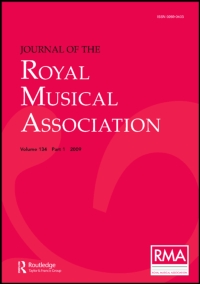No CrossRef data available.
Article contents
On form in Musical Composition
Published online by Cambridge University Press: 01 January 2020
Extract
On receiving the invitation of the Council of this Institution to read a paper on Form in Musical Composition, my first impression was that so comprehensive a subject could scarcely be treated within prescribed limits, which would admit of little more than a dry and incomplete catalogue of the numerous kinds of musical composition to which the word form is applicable. It occurred to me, however, that by taking the subject as referring to movements of large scope, and comprising numerous component parts, I might select one form of such works, analyse it more fully than has been attempted in didactic treatises, and so present a paper of reasonable duration, and, as I hope, not without some features of interest. It will doubtless be anticipated that I have chosen for my remarks that most important form of instrumental composition known as the Modern Binary or Grand Duplex—the general form of the great majority of modern classical overtures, and of first (and frequently also of other) movements of symphonies, sonatas, and the whole range of concerted instrumental music. I premise that I purpose treating my subject chiefly from the scholastic point of view, not only as being most in accordance with the general objects of our meetings, but because the aesthetic or poetic aspect would lead us too far into the regions of speculation and romance.
- Type
- Research Article
- Information
- Copyright
- Copyright © Royal Musical Association, 1878
Footnotes
Illustrated on the “New Patent Vocalist's Double Oblique Pianoforte,” invented by John C. Ward, Esq., and manufactured by W. Whiteley, 147, Queen's Road, Bayswater.
References
∗ Since reading this paper I have been reminded by an esteemed professional friend that the first part of Mendelssohn's “Military Overture” is marked with a repeat. But this work is certainly not an overture in the ordinary acceptation of the term. It is simply a movement; and it appears to me that Mendelssohn careful as he was in the composition and revision of his works, was, as in this instance, less so in classifying them. Of this there is strong further evidence in his Op. 22, which was originally published in England as “Rondo Brillante.” But it is not a rondo, of which the author would seem to have been reminded, as in subsequent editions it appears as “Capriccio Brillante.” But neither is it a capriccio—a name which, with its cognates, Mendelssohn largely used in designating his pianoforte works, viz., “Caprice,” Op. 5; “Rondo Capriccioso,” Op. 14; “Three Caprices,” Op. 16; “Capriccio Brillante,” Op. 22; and “Three Caprices,” Op. 33; all of which art movement of regular design and purpose.—C. E. S.Google Scholar
∗ For an instance of wholesale abbreviation, see first movement of Dussek's Pianoforte Sonata in G, Op. 35, No. 2.Google Scholar
† In Mozart's overture, “Titus,” and in the first movement of his Pianoforte Sonata in D, commencing thus:Google Scholar

the free fantasia is immediately followed by the second principal motivo, transposed, and the resumption of the primary motivo brings the movement to a close. This is a very unusual modification.Google Scholar


